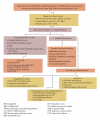Cobalamin and folic Acid status in relation to the etiopathogenesis of pancytopenia in adults at a tertiary care centre in north India
- PMID: 22545211
- PMCID: PMC3321527
- DOI: 10.1155/2012/707402
Cobalamin and folic Acid status in relation to the etiopathogenesis of pancytopenia in adults at a tertiary care centre in north India
Abstract
Background. Pancytopenia has multiple etiologies like megaloblastic anemia, aplastic anemia, leukemia, and various infections. We investigated the clinical, etiological and hematological profile including bone marrow morphology of patients with pancytopenia in relation to their vitamin B12 and folic acid status at a tertiary care referral hospital in north India. Methods. A total of 140 consecutive patients with pancytopenia were selected from June 2007 to December 2008. Bone marrow examination and other tests were carried out as warranted, including serum cobalamin and folate assays using liquid chromatography mass spectroscopy (LC MS/MS). Results. The study population consisted of 92 males and 48 females with a mean age of 32.8 years. Megaloblastic anemia 60.7%, aplastic anemia (7.8%), and leukemia (9.2%) were common causes. Infectious causes (16.4% of all cases) included leishmaniasis, HIV-AIDS, malaria and tuberculosis. Severe cobalamin deficiency (B12 < 100 pg/mL) was seen in 81% of all patients including 91.6% of patients with MA. In contrast, only 7.14% of all pancytopenic patients were folate deficient. Folate deficiency (<5 ng/mL) was seen in just 5% MA patients. Combined cobalamin and folate deficiency was seen in 5 patients (3.51%). Conclusion. Cobalamin deficiency was found to be more common in our setting and is largely underdiagnosed in the age of folate supplementation. Infectious diseases like tuberculosis, leishmaniasis, and increasingly HIV are important and treatable causes of pancytopenia. This is in contrast with the developed nations where the bulk of disease is due to malignancy or marrow aplasia.
Figures





Similar articles
-
Clinico-hematological profile of pancytopenic adult patients in a tertiary care teaching hospital.Tzu Chi Med J. 2021 Aug 23;34(1):95-101. doi: 10.4103/tcmj.tcmj_17_21. eCollection 2022 Jan-Mar. Tzu Chi Med J. 2021. PMID: 35233363 Free PMC article.
-
Pancytopenia in children: A 6-year spectrum of patients admitted to Pediatric Department of Rehman Medical Institute, Peshawar.Pak J Med Sci. 2013 Sep;29(5):1153-7. doi: 10.12669/pjms.295.3865. Pak J Med Sci. 2013. PMID: 24353710 Free PMC article.
-
Pancytopenia Secondary to Vitamin B12 Deficiency in Older Subjects.J Clin Med. 2023 Mar 6;12(5):2059. doi: 10.3390/jcm12052059. J Clin Med. 2023. PMID: 36902847 Free PMC article.
-
Laboratory testing for cobalamin deficiency in megaloblastic anemia.Am J Hematol. 2013 Jun;88(6):522-6. doi: 10.1002/ajh.23421. Epub 2013 Mar 15. Am J Hematol. 2013. PMID: 23423840 Review.
-
Update on cobalamin, folate, and homocysteine.Hematology Am Soc Hematol Educ Program. 2003:62-81. doi: 10.1182/asheducation-2003.1.62. Hematology Am Soc Hematol Educ Program. 2003. PMID: 14633777 Review.
Cited by
-
Clinico-hematological profile of pancytopenic adult patients in a tertiary care teaching hospital.Tzu Chi Med J. 2021 Aug 23;34(1):95-101. doi: 10.4103/tcmj.tcmj_17_21. eCollection 2022 Jan-Mar. Tzu Chi Med J. 2021. PMID: 35233363 Free PMC article.
-
Spectrum of Pancytopenia in Adults Attending a Clinical Hematology Department: A Four-Year Experience From a Tertiary Care Center of Western India.Cureus. 2022 May 12;14(5):e24933. doi: 10.7759/cureus.24933. eCollection 2022 May. Cureus. 2022. PMID: 35706755 Free PMC article.
-
A Study of Clinical Profile of Vitamin B12 Deficiency with Special Reference to Dermatologic Manifestations in a Tertiary Care Hospital in Sub-Himalayan Bengal.Indian J Dermatol. 2015 Jul-Aug;60(4):419. doi: 10.4103/0019-5154.160506. Indian J Dermatol. 2015. PMID: 26288424 Free PMC article.
-
B Vitamins and One-Carbon Metabolism: Implications in Human Health and Disease.Nutrients. 2020 Sep 19;12(9):2867. doi: 10.3390/nu12092867. Nutrients. 2020. PMID: 32961717 Free PMC article. Review.
-
Pancytopenia of Unknown Cause in Adult Patients Admitted to a Tertiary Hospital in Ethiopia: Case series.Ethiop J Health Sci. 2018 Jul;28(4):375-382. doi: 10.4314/ejhs.v28i4.3. Ethiop J Health Sci. 2018. PMID: 30607050 Free PMC article.
References
-
- Young NS. Aplastic anemia, myelodysplasia, and related bone marrow failure syndromes. In: Kasper DL, Braunwald E, Fauci AS, editors. Harrison’s Principles of Internal Medicine. 17th edition. McGraw Hill; 2008. pp. 663–671.
-
- Guinan EC, Shimamura A. Wintrobes’s Clinical Hematology. 11th edition. Lippincott, Williams and Wilkins; 2004. Acquired and inherited aplastic anemia syndromes; pp. 1398–1419.
-
- Satterfield MB, Sniegoski LT, Sharpless KE, et al. Development of a new standard reference material: SRM 1955 (homocysteine and folate in human serum) Analytical and Bioanalytical Chemistry. 2006;385(3):612–622. - PubMed
-
- Ueland PM, Midttun Ø, Windelberg A, Svardal A, Skålevik R, Hustad S. Quantitative profiling of folate and one-carbon metabolism in large-scale epidemiological studies by mass spectrometry. Clinical Chemistry and Laboratory Medicine. 2007;45(12):1737–1745. - PubMed
-
- Pfeiffer CM, Fazili Z, McCoy L, Zhang M, Gunter EW. Determination of folate vitamers in human serum by stable-isotope-dilution tandem mass spectrometry and comparison with radioassay and microbiologic assay. Clinical Chemistry. 2004;50(2):423–432. - PubMed
LinkOut - more resources
Full Text Sources

